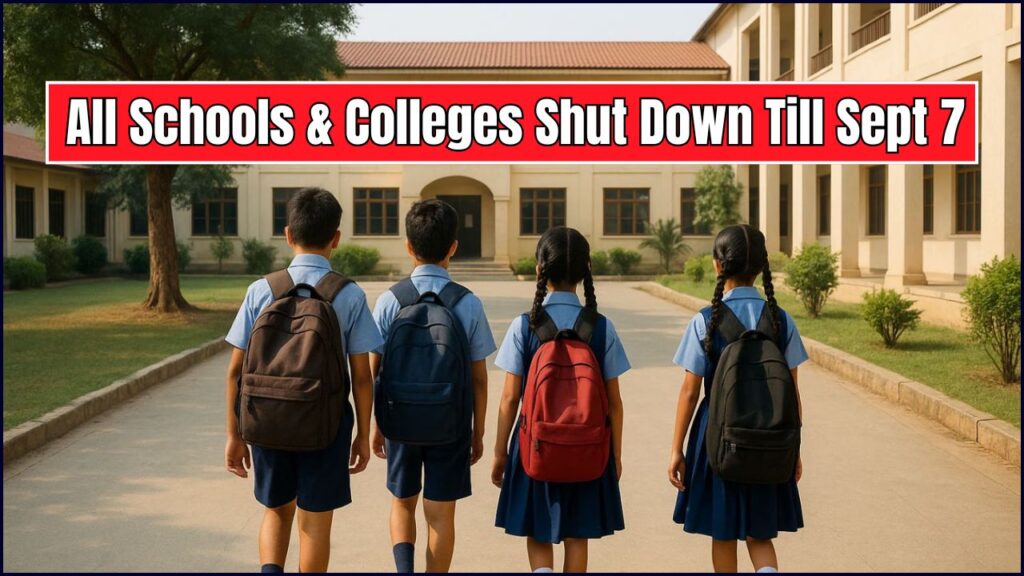
Several North Indian regions have shut educational institutions due to flooding and landslides, but nationwide closures have not been ordered; this applies in Punjab, Himachal Pradesh, and Chandigarh until 7 September, while other states issued shorter, district-specific curbs tied to weather alerts. Orders cite safety risks, disrupted transport, and continuing rain forecasts.
What is closed till Sept 7
Punjab, Himachal Pradesh, and Chandigarh have extended closures for schools and higher education through 7 September due to floods and persistent heavy rain, according to state and city authorities and contemporaneous reporting. The Punjab Education Minister announced the order, covering government, aided, recognised, and private schools, colleges, universities, and polytechnics.
In Himachal Pradesh, the government directed all government and private schools and colleges, including District Institutes of Education and Training (DIET), to remain closed until 7 September, citing landslides, blocked roads, power outages, and infrastructure damage. The Himachal Pradesh University and its centres are also shut during the period.
Chandigarh extended the closure of all schools to 7 September due to incessant rain, according to city authorities and local education coverage. The extension followed earlier short-term orders as rainfall continued across the region.
Where closures are shorter or local
Authorities in Jammu and Kashmir, Haryana, Uttar Pradesh, and parts of Delhi-NCR have issued short-duration or district-level school holidays aligned with India Meteorological Department alerts and local flood conditions. Daily updates have included one- or two-day closures, online class advisories, or localized restrictions in flood-hit districts.
Coverage indicates closures on 3–4 September across parts of Jammu division and Delhi-NCR, with Noida’s one-day holiday and potential extensions contingent on weather. Haryana districts have alternated between full closures and staff-only operations, reflecting highly localised impacts from rainfall and waterlogging.
Uttar Pradesh districts, including Meerut, Mathura, Hapur, and Agra, announced day-specific closures on 4 September, with reopening subject to local assessments. Officials have recommended monitoring district magistrate notices for real-time changes.
Why closures were extended
Officials cited multiple hazards: continuing rain bands over the western Himalaya and northwestern plains, landslides and falling trees in hill states, and road blockages and power outages. These factors, combined with forecast uncertainty and ongoing rescue and repair operations, drove precautionary decisions to keep campuses closed through 7 September in the worst-affected areas.
In Himachal Pradesh, orders referenced widespread damage to public infrastructure and the need to protect students and staff from travel risks. Punjab’s decision followed reports of flooding across several districts, prompting the Education Minister’s statewide directive after a shorter closure window proved insufficient.
What authorities and experts say
“Keeping in view the flood situation, all Govt/Aided/Recognized & Private Schools, Colleges, Universities & Polytechnics across Punjab will remain closed till 7th Sept 2025,” said Punjab Education Minister Harjot Singh Bains, attributing the direction to the Chief Minister and urging compliance with local guidelines. The announcement was disseminated through an official statement carried by mainstream outlets.
Himachal officials said the decision was a preventive measure due to a “high likelihood” of further rain and landslide risk, instructing institutions to run online classes wherever possible and to safeguard campus assets. The Himachal Pradesh University and affiliated centres were included in the directive.
Live coverage from established media described Delhi-NCR under weather alerts with intermittent district closures and advisories, reflecting fast-changing conditions rather than a blanket, long-duration order. Authorities emphasised continuous monitoring over fixed, statewide timelines outside the worst-hit regions.
Exams and academic continuity
Reporting indicates that some professional examinations were postponed at select centres due to weather-related disruptions, and institutions were encouraged to maintain continuity via online classes where feasible. This approach is consistent with previous monsoon-season protocols in flood-affected regions.
Himachal’s order explicitly exempted teachers and administrative staff from physical attendance while asking heads of institutions to remain vigilant and protect records and equipment, reflecting safety-first planning while preserving core academic functions remotely.
What parents and students should do
Check district administration and state education department notices daily, as orders may change with new weather data and field assessments. For metropolitan areas outside the three regions with fixed Sept 7 closures, local officials are using short, rolling advisories.
When possible, follow school or college communications for online class schedules, rescheduled exams, and transport advisories. Given infrastructure stress in hill districts and floodplains, authorities have urged caution in travel and adherence to safety guidance.
The bottom line
There is no nationwide closure of educational institutions. The shut down applies in Punjab, Himachal Pradesh, and Chandigarh through 7 September, while other states and districts are using shorter, rolling orders aligned to local risk and weather forecasts. Parents and students should rely on official state and district channels for the latest instructions.





